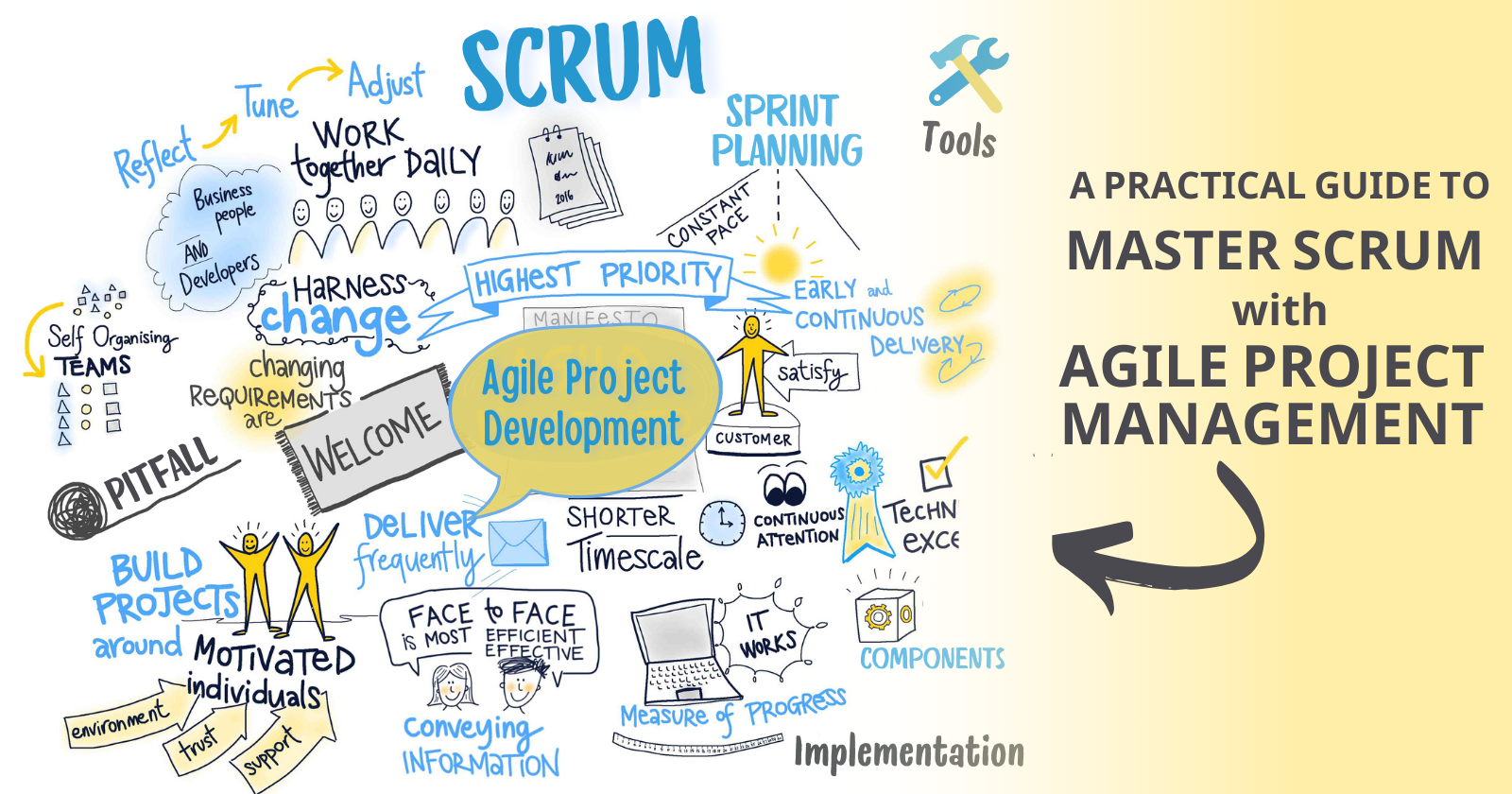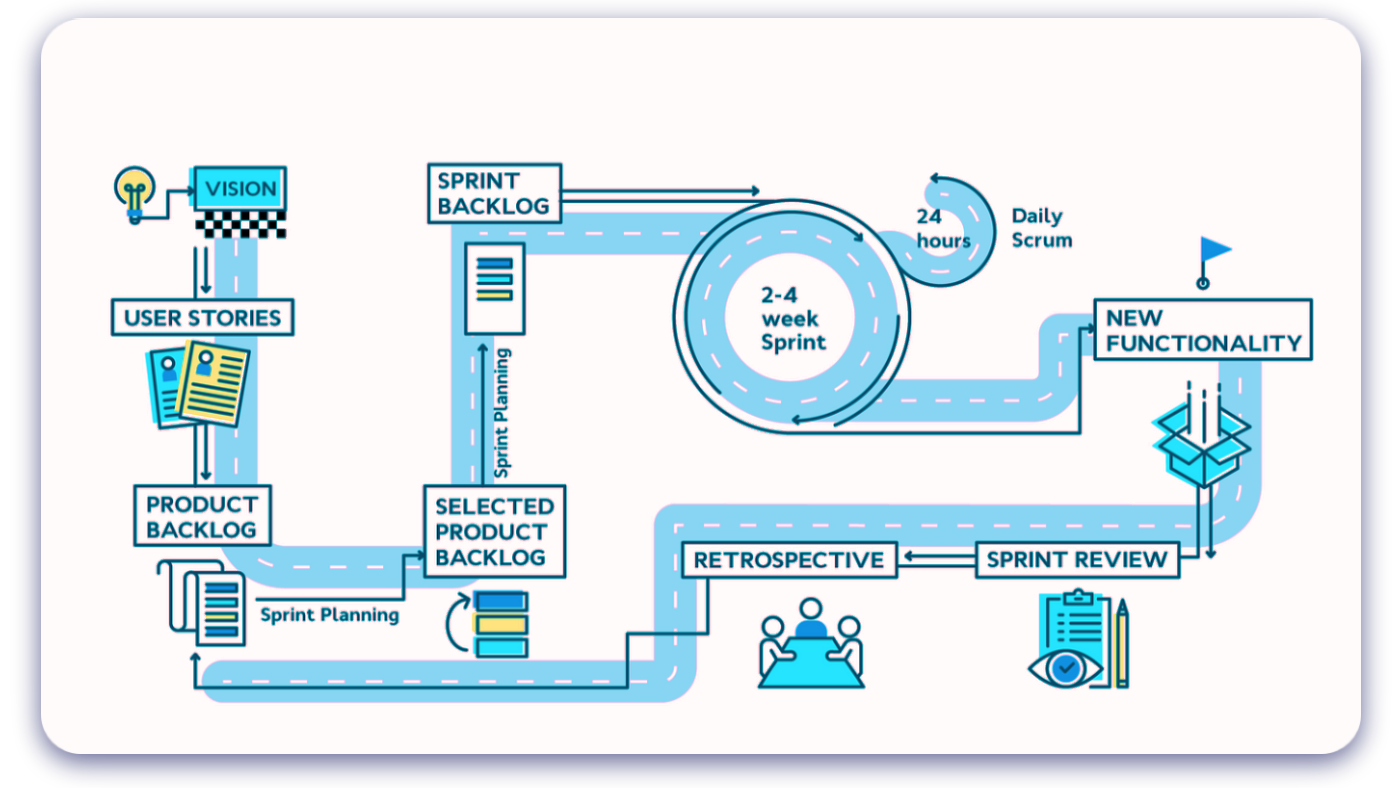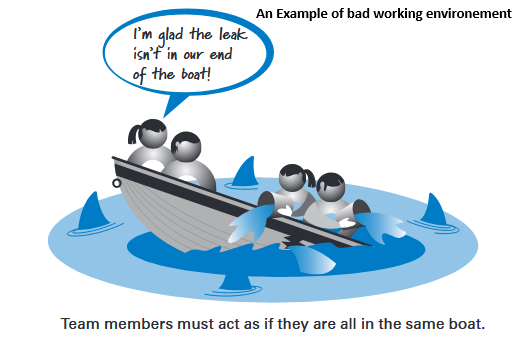A Practical Guide to Master Scrum with Agile Project Management
 Adya Prasad
Adya Prasad
Introduction
Traditional project management methods (Waterfall and PRINCE2) have often struggled to keep pace with changing requirements and the need for scalability. Therefore, we practically adopt the Agile Project Management approach which has emerged as a modern solution and provides an iterative approach to managing projects in a dynamic environment.
Whether you are an experienced software developer, project manager, or new to the Agile landscape, this guide is for you, I have read many articles and watched tutorials on Scrum with Agile, which I am summarising here.
After reading this master scrum guide. You will be able to apply Scrum and Agile in real-world scenarios, achieve specific goals, and master Scrum with Agile. Read this guide till the end so that you can get a strong idea of how Agile and Scrum work.
We will emphasize the importance of practical implementation and problem-solving over theoretical knowledge.
Scrum and Agile in Project Management
“We need to be Agile!” “Let’s implement Scrum!” You might have heard these phrases thrown around in an academy, organization or workplace as you decide to start on a software development project. Let’s clear it.
Agile is a set of values and principles that guide your work with frequent inspection and adaptation.
Agile project management is an iterative approach to managing software development projects that focuses on continuous releases and incorporating customer feedback with every iteration.
Scrum is an agile project management framework that helps teams structure and manage their work through a set of values, principles, and practices to “deliver as much quality software as possible within a short sprint (iteration) series. The Scrum framework comprises three roles, five events, and three artifacts.
Scrum encourages teams to learn from experience, self-organize while solving problems, and reflect on their victories and failures to continuously improve. It is one of the most efficient and streamlined project management methods out there.
According to the Agile Manifesto
You implement these methodologies with core values:
Individuals and interactions over processes and tools
Working software over comprehensive documentation
Customer collaboration over contract negotiation
Responding to change over following a plan, read more in the official Agile Manifesto
Understanding the Main Components of Agile and Scrum
Collaboration: Encouraging open communication between the Scrum Master, cross-functional team, owner, IT, and stakeholders to accomplish the goals outlined in the project vision and deliver project deliverables.
Cross-Functional Teams: Agile project management relies on cross-functional teams that include members from different departments such as development, testing, and design. The team should be loosely coupled and tightly aligned; this will allow teams to work together to deliver a high-quality software product.
User Story: This is an informal, short, general explanation of a software feature written from the perspective of the end user (customer) to understand the requirements. These include: Who is it for? what do they need? And why are they needed?
Sprint: This is a predefined period in which teams work together to accomplish specific goals. This is decided in the sprint planning meeting. Sprint is called the heartbeat of Scrum where ideas are turned into value.
Daily stand-up meetings: These are quick daily meetings where everyone talks about what they're working on. This helps you stay informed and focused on achieving sprint goals with reviews with status.
Product Backlog: This is an ordered list of prioritized tasks for the scrum team in order of need to accomplish the goal. This includes features, bug fixes, infrastructure changes, or other activities that the Agile team needs to work on. It is considered an 'artifact' within the Scrum software development framework.
Spring Retrospective: This meeting is held after the sprint ends (refers to the last meeting), where members reflect on what went well and what can be improved for their next sprint (measure the health of the process). It is conducted after the Sprint Review and before starting the next Sprint Planning.
Agile Board: It is a visual representation of an agile development and management process to track the current status, team performance, and progress toward completing each task. It is also used to track bugs, features, sprints, and tasks in backlog.
Stakeholders: It refers to people outside the Scrum team who have an interest in the product developed and project management but are not part of the Scrum Team.
How to Implement Scrum in an Agile Project
86% of software developers worldwide adopt Agile as their business practice. It is interesting to know how it started as a set of loose principles and became a mainstay in project management across various industries.
The 17th Annual Agile Report shows that the global Agile development tools market is projected to reach $9.2 billion by the end of 2024, up from $5.7 billion in 2020 and Scrum dominates as the most implemented Agile framework, used by nearly 70% of Agile practitioners
With this inspiration let's start implementing Scrum with Agile. I will guide you in 6 detailed steps

Step 1: Understanding Basics: Project Vision, Roadmap, and Completion
Scrum is built on values such as clear goals, transparency, inspection, and adaptation. One should start by brainstorming the product, planning the project goal, and deciding on the required team and completion deadline. Proper organization is critical to success.
To keep your planning meeting focused, try using the Elevator Pitch method, consider the following:
For: (Your Target Customer)
Who: (Statement of the Need)
The: (Product Name) is a (Product Category)
That: (Key Product Benefit, Compelling Reason to Buy and/or Use)
Unlike: (Primary Competitive Alternative)
Your Product: (Final Statement of Primary Differentiation)
When should the meeting be held and who should attend it?
Scrum meetings help teams, stakeholders, and management to stay aligned throughout a project so they need to participate. If you already have a development team they should participate too. It should happened on the first day
Step 2: Prepare the Functional Scrum Team
Ideal team revolves around the three key roles Product Owner, Scrum Master and Development Team.
A Scrum team is a mix of cross-functional teams that perform tasks in a order to achieve goals with great collaboration and communication. A Scrum team may be as small as 3 people for a simple project, while no project is large enough to need more than 9 people.
The Scrum Master will guide other team members through the Scrum framework and help overcome any obstacles that may slow down the team's efforts. The Product Owner is in charge of setting the direction of a project. The team must have a clear understanding of what the business and users need.
Make sure the team is cross-functional and self-organizing with all the skills needed to complete the project. Create smaller teams to maintain agility or prepare large size teams to handle the big project workload.
The Scrum Team includes Programmers, Architects, Writers, Designers, Cloud specialists, Subject Matter specialists (SMEs) and others as per project needs.
The factors that influence a team are communication, collaboration, self-management, dedication, cross-functionality and vision alignment.
[Note: Step 1 and Step 2 can be interchanged as per the project need and owner perspective.]
Step 3: Product Backlog and Backlog Refinements
Depending on the meeting role of team members, the Scrum Master implements Scrum with Agile methodology. The team starts with the product backlog by evaluating how much effort will be required to complete the product backlog item (PBI). Because the product is the key that everyone is working on.
You already know that product backlog is an ordered list of prioritized tasks for the scrum team in order of need to accomplish the goal. This includes features, bug fixes, infrastructure changes, or other activities that the Agile Team needs to work on. Backlog refinement means ensuring all things are ready.
A backlog will typically contain 2 types of work items:
Epics – What about really big ideas? Well, really big ideas are called epic. A user story that is bigger than a single sprint becomes epic.
Stories - More detailed requirements for what should be done (be possible to do). An epic can typically be broken down into several stories.
Step 4: Planning and Running Your First Sprint
Based on backlog priority, the team now picks items from the list (usually from the top). The team brainstorms and decides what is in the sprint, what needs to be accomplished, what is needed for operation, and how quickly it can be accomplished. This is called a sprint planning meeting.
Sprint planning sets the tone for the cycle and occurs at the beginning of each sprint cycle. For example, if you're doing weekly sprints, you'll do a planning session every Monday (or whatever day of the week you want to start).
And then the team completes the sprint according to the criteria decided in the sprint meeting. If you are working on a small project with a small team make sure that anything does not go over like over-code and over-engineer
A meeting where your team comes together to discuss three things:
What did you complete yesterday?
What are you working on today?
Are there any roadblocks getting in the way?
Step 5: Sprint Review and Retrospective
Live demonstration of implemented stories. The Sprint Review and Retrospective focuses on reviewing and demonstrating the work completed during the Sprint and discussing the scope of future work for the product.
The sprint is about improving the work process, what went well and needs to continue like that, identifying areas for better teamwork in the next sprint, and determining how the team worked collaboratively during the sprint and also about where the team failed.
| The main purpose of sprint reviews: |
| Demonstration of completed work |
| Adding labels on different completion |
| Feedback collection |
| Alignment with product vision |
| Celebration of achievements |
| Identification of improvements |
The sprint retrospective meeting takes place immediately after the sprint review. Where the team talk about their own condition.
Step 6: Decision-Making and Next Sprint Planning
The team makes decisions based on what became clear in the retrospectives.
Typically, Scrum Team will create a Scrum Board – a large piece of paper – with 3 or 4 columns, or use any of the digital versions. Each Product Backlog Item (PBI) is written on a sticky note or digital block and placed in a column to show that it is planned for that Sprint, in progress, or completed.
One of the core principles of Agile project management is that it’s sustainable. This means you should be ready to start on the next sprint as soon as the previous one ends.
There's no limit for the number of sprints, except if they are set by a deadline (based on budget or time), or the entire backlog is completed. If none of these criteria are met, the sprints just keep going indefinitely.
Also read: Best Way to Build Jenkins CI/CD Pipeline on Kubernetes in 2024
Measuring Success: Metrics in Scrum and Agile Project Management
According to Atlassian, metrics are a sensitive topic that provides insight into productivity through different stages of the software development lifecycle. This helps in assessing the quality of a product and tracking the performance of the team.
It’s important to note that "A program's business metrics should be rooted in its roadmap."
Although there are many metrics to be monitored, it is completely based on the outline of the project as to which metrics the team has to use and monitor. Sometimes the team decides to create their own customized metrics to measure. Some essential metrics are:
Sample Operational Metrics:
Lead Time: Lead time measures how long it takes to complete a requested feature or task and deliver it to the customer.
To calculate lead time, the essential information to know is the date/time at which the team receives the requirement or request and the date/time at which the team completes the requirement.
Lead Time = Order received – Order deliveredCycle Time: When a new task shows up on your list, it as a rule should be investigated and authenticated before it goes to the team for work and the team started working on it.
Cycle time refers to the time taken from when a task is actively worked on until it is completed. It’s a subset of lead time and focuses on the time taken for development after work begins. It’s a subset of lead time and focuses on the time taken for development after work begins.
Cycle Time = Work in progress / ThroughputBurndown Chart: This is a key parameter used in Agile Software Development and Scrum to measure how much work is left to be completed. It is used to measure the team's progress, showing the amount of work that has been completed in an epic or sprint and how much total work remains.
Sample Output Metrics:
Throughput: Throughput measures the average number of work items processed per unit of time. In general, throughput is one of the most crucial Agile performance metrics.
It gives you great details into your team's real capabilities, so you can better plan how much work you can deliver in a given period.Agility Assessment Model: The agility assessment model is used to measure the degree of agility of an Agile-using organization.
Furthermore, an Agile Maturity Assessment is done to evaluate the current state of Agile Maturity and to check how successful Agile implementation is in an organization.Technical quality/defect measurements/code coverage: These metrics assess the quality of the code and product.
Technical quality:Evaluates aspects like adherence to coding standards.Defect measurements:Track the number of bugs or issues found in the product.
Code coverage:Measures the percentage of code tested by automated tests, aiming for higher coverage to ensure reliability.# of features: This metric tracks the number of new or custom features delivered by the team over a specific time frame.
Sample Outcome / Value Metrics:
Team morale: This is an overall satisfaction and productive environment metric that focuses on maintaining a productive and collaborative environment. Usually, this is measured by the Scrum Master. Higher morale leads to better project workflow
Customer Satisfaction/NPS: Customer satisfaction or Net Promoter Score (NPS) is a customer and stakeholder satisfaction metric. It is customer-centric metrics primarily measuring customer feedback, engagement, and how much one customer recommends your product to another. NPS is the standard measurement for measuring customer loyalty and satisfaction on a scale of
0 to 10.Business Value: Business Value results from the intersection of three dimensions.
1.What you can implement successfully and sustainably,2.What your customers want and will buy (even if they don’t know it yet), and3.What your team is excited about creating.
Practical Use Cases
| Well-known use cases are: |
| In Software Project Management: Well-implemented Agile software development methodology helps teams significantly improve the quality of their software with each release. Not only this, it allows teams to adapt to rapid changes as per market trends and demands thereby gaining a better competitive edge. In these systems, customer demand drives the product development rate thereby providing the right service at the right time. |
In DevOps and IT Operation: Now you have read above that Agile and Scrum are based on iteration so that they can be easily implemented in DevOps components like Continuous Integration and Continuous Delivery (CICD) and Infrastructure as Cods (IaC). CICD pipelines are the backbone of cloud infrastructure, Scrum's iterative sprints and Agile's adaptability complement these pipelines by creating a structured environment where changes are incrementally developed, tested, and deployed. Agile + DevOps = Perfect Alignment |
| In Product Development: Agile product development refers to a set of product development practices and methods based on the principles and values of the Agile Manifesto. Since Agile is based on iteration, each iteration is like a 'mini project' that includes all stages of the product development process, from product discovery to release so that in the final iteration the product team delivers a working product to customers |

Common Pitfalls and How to Avoid Them
According to the Project Management Institute, more than 70% of organizations incorporate Agile approaches and 77% adopt Scrum. Unfortunately, 46% of all Agile and Scrum transformation organizations fail. Therefore, we should follow and implement everything mutually.
Because Agile is not just a methodology you follow, it is a mindset you adopt. It's a philosophy that requires you to think differently about managing teams and projects
Micromanagement (the act of trying to control every aspect of how a task is completed). At the heart of Agile Scrum is the idea of empowering the team with “autonomy to make decisions”. Micromanaging the team can have adverse effects on their motivation, creativity, and productivity.
Ignoring feedback from the Team: Agile Scrum promotes a continuous feedback loop between the team and the stakeholders. Ignoring feedback can result in misaligned expectations and a lack of understanding of the project’s objectives.
Non-collaborative and ambiguous environment: Communication is essential in Agile Scrum, and the team must be transparent and open with each other. Failure to communicate can lead to misunderstandings, delays, and missed opportunities. The team must communicate regularly and effectively using the appropriate tools and channels.
Neglecting backlog refinement: Not doing enough backlog refinement can lead to a low-quality product backlog with a lot of ambiguity. Many Scrum Teams have become accustomed to very long Sprint Planning meetings. Yet, backlog items are not ready to be implemented smoothly enough for Sprint, and they have begun to disrupt the flow of backlog refinement.
The formula for failure: Wrong transferring, placing existing team into new roles without training and skill set. Making the Product Manager the Product Owner, the Project Manager becomes the Scrum Master, and the Developers Team in the Scrum Team.
These are just a few examples of pitfalls in the Scrum framework. To be successful, you'll need to adopt an agile mindset and create a collaborative, open environment.
I hope this guide helps you and gives you a practical idea for implementing Scrum in Agile Project Management❤️
If you have any questions or suggestions, comment down I would love to react 📝
Subscribe to my newsletter
Read articles from Adya Prasad directly inside your inbox. Subscribe to the newsletter, and don't miss out.
Written by

Adya Prasad
Adya Prasad
Specializing in AI and Cybersecurity, Love to Write Guide and Tutorial. Harvard CS50x | Contact me to solve WordPress and SEO problem.